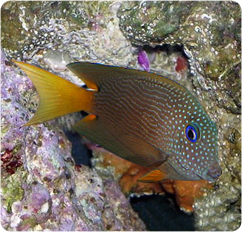|
Ctenochaetus binotatus - Blue Eye Tang
A Great Algae-Grazing Tang for Reef Tangs  The blue eye tang (Ctenochaetus binotatus), also called the two-spot surgeonfish or the two-spot bristletooth, is a reef-associated, Indo-Pacific saltwater fish that is a fantastic, although often underrated, algae-eater. Better yet, the blue eye tang is reef safe, making it an ideal marine aquarium fish for those aquarists who also keep coral and other invertebrates. Growing to about 22 cm in length, the blue eye tang inhabits deep lagoon and seaward reefs where it feeds amongst rubble zones. It eats by literally scooping detritus and algae off of the rock using its protrusible mouth with specialized bristle-like teeth The blue eye tang (Ctenochaetus binotatus), also called the two-spot surgeonfish or the two-spot bristletooth, is a reef-associated, Indo-Pacific saltwater fish that is a fantastic, although often underrated, algae-eater. Better yet, the blue eye tang is reef safe, making it an ideal marine aquarium fish for those aquarists who also keep coral and other invertebrates. Growing to about 22 cm in length, the blue eye tang inhabits deep lagoon and seaward reefs where it feeds amongst rubble zones. It eats by literally scooping detritus and algae off of the rock using its protrusible mouth with specialized bristle-like teeth
The care of this fish is not difficult in the home aquarium so long as the aquarist keeps several guiding principles in mind. First and foremost is the need for space. This fish, as an adult, should not be housed in an aquarium that is less than 70 or 75 gallons. The tank should have plenty of live rock with nooks and crannies, as well as swimming space. Circulation should be brisk.
The second guiding principle is to keep in mind the need for forage. This fish will spend its days feeding on algae growing on the substrate, and it is therefore necessary to keep this animal in a tank that has plenty of algae growth. An algae-free aquarium is NOT ideal for this animal, unless the aquarist plans to frequently rotate algae-covered feeder rocks into and out of the aquarium. While it is important for the reefkeeper to have a filtration system that provides the requisite water quality for keeping many species of coral, it is essential that the filtration system not be too robust and that the tank be appropriately stocked (or, better yet, understocked).
The blue eye tang should not be kept with members of its own species, although it often does well with other tangs, as long as the other tangs are significantly different in size and coloration. As mentioned above, this fish is generally considered to be reef-compatible, and it should leave coral polyps and most other reef invertebrates alone.
Acclimate this fish as you would other fishes, but do spend some extra time making sure that the blue eye tang is feeding in the quarantine tank. Offer a piece of rock rubble with copious algae growth to the quarantine tank right away. In addition to live algae, plan to offer a carnivorous food that has been pre-soaked in a vitamin supplement like Selcon. Getting your blue eye tang eating quickly will go a long way to a smooth acclimation and a long-lived healthy fish.
Overall, the blue eye tang is a wonderful addition to many community reef and fish-only systems so long as the animal’s needs are considered. This is a beautiful, behaviorally-interesting species that will provide years of utility through its efficient algae-grazing.
|